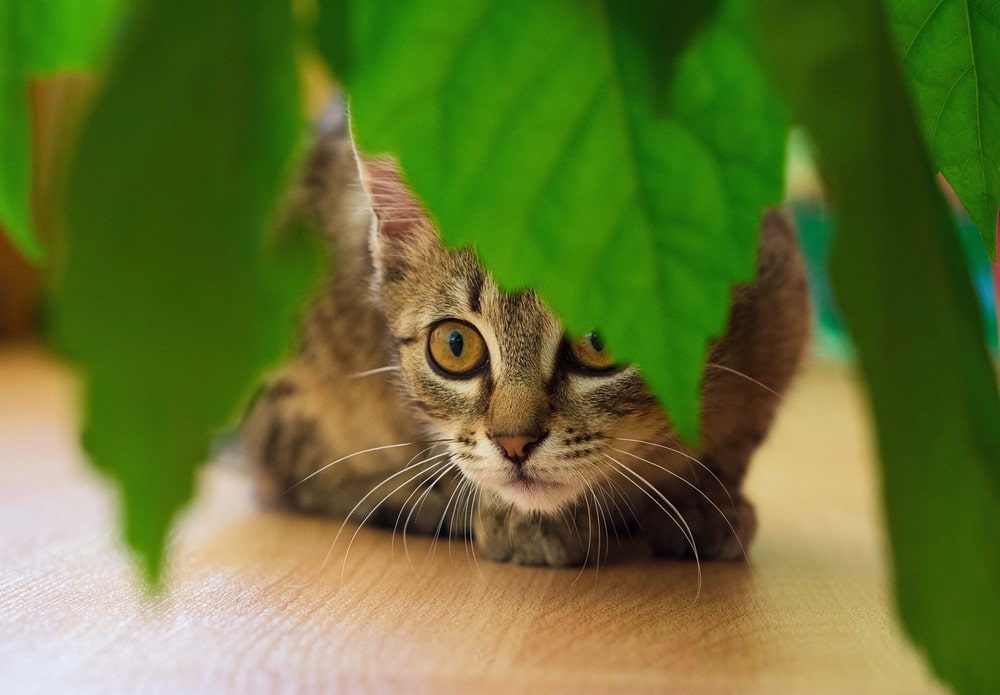You can find lists everywhere about which plants are toxic for cats/dogs/small children but what’s harder to find is a list of plants that are safe. Here is a list of houseplants known to be non-toxic. Do understand that a child or pet could still have an allergic reaction, however. Whenever there is any question, seek medical attention.
African Violets—One of the most reliable blooming plants for indoors, African violets need a couple of hours of direct sun, before 10:30 a.m. or after 3:00 p.m. Water when the top feels dry to the touch, being careful not to get water on the foliage.
“Air” Plants—They are fun plants to tuck in a seashell, mount on a piece of wood, etc. They prefer the same light as does an African violet. Because they generally don’t have soil around their roots, mist lightly every couple of days. About once a week, float in a bowl of room temperature water for about 5 minutes.
Areca Palm (Golden Palm)—Areca palms are best in very bright indirect light to direct sun—preferably before 11 in the morning or after 3 in the afternoon. Water when the top two to three inches of soil is dry. A daily light misting is beneficial.
Bamboo Palms—Bamboo palms do best in the same conditions as does the Areca palm.
Bird’s Nest Fern—This is a pretty and durable fern that tolerates bright indirect light. Like all ferns, it likes humidity so misting is helpful.
Boston Ferns—we all love those pretty lacy leaves. To keep a Boston looking its best, keep it in bright indirect light, keep evenly moist (but not soggy) and mist daily. They love to go outside in the shade for the summer.
Christmas Cactus—Holiday cactus prefer about the same light as does an African violet. It’s easy to get them to bloom again if you put them outside for the summer (under a tree in dappled sun only) and leave them until mid-October. They need the combination in early fall of shorter day length and cooler nights to set buds.
Haworthia—Haworthias are beautiful little succulents with spiky striped leaves. They are super easy to grow in a sunny window. Allow them to dry out before watering.
Hoya (Wax Plant)—Hoyas are succulents with pretty thick waxy foliage. They are easy durable vines that are great in hanging baskets or trellised up. They prefer two or three hours of direct sunlight and should go fairly dry between waterings.
Orchids—Which variety of orchid you can grow will depend on how much light you have. Phalaenopsis orchids (also known as Moth Orchids) need only the same kind of light as does an African violet to bloom. There are other varieties of orchids which need more light. Come see us for help in deciding which variety would do best for you.
Parlor Palms (Neanthe Bella)—Parlor Palms are easy indoor palms. They need only bright indirect light. Like all palms, they appreciate a light misting.
Ponytail Palms—a Ponytail palm is a succulent— like all plants native to desert-type environments, it likes some sunlight and can go just about completely dry between waterings.
Prayer Plants—There are several varieties of Prayer plants but they all are known for folding their leaves at night. Prayer plants thrive in bright indirect light and do prefer extra humidity so mist lightly every day.
Spider Plant—Spider plants make such gorgeous hanging baskets—and fun when they make the little baby spiders! Keep them in a fairly bright window—avoiding hot mid-day or afternoon sun. Allow them to dry out partially between waterings. Letting tap water stand overnight for the chlorine to evaporate will help prevent brown tips on the foliage.
Swedish Ivy—Swedish ivy is another pretty vining plant with glossy leaves with scalloped edges. Treat them pretty much the same you would treat a spider plant.
There are some other plants that are also non-toxic such as bromeliads, staghorn ferns, Money trees (Pachira aquatic), peperomias, echeverias (hens-and-chicks) so do your research to be sure. By the way, a note here: There are several palms and ferns that are not toxic but that doesn’t mean they are all non-toxic. While Areca, Bamboo and Parlor palms are non-toxic, Sago palms are extremely toxic.
Remember, if you have a plant like a philodendron that pets should not eat, you can always grow them in a hanging basket or set tall plants up on a plant stand to keep the foliage out of their reach (if you have cats, don’t put them on a stand next to a shelf where they can jump up and get to them anyway).
As someone who has four indoor cats, I can say that if I bring anything into the house with long skinny leaves, my cats will think it’s grass and try to eat it. So even though an Areca palm is not toxic, I’d still wind up with chewed on foliage. I do keep my Parlor palm on a stand and my spider plant hanging in front of a window.
Come in and let us help you find that perfect pet-friendly plant for your location.


I want to purchase some mint plants that are not poisonous to my dogs. Which ones should I purchase?
Hi Sharon–Because all mints are related, all contain pretty much the same essential oils so I don’t think there are any that are not toxic. I have a neighbor who grows it in a pot on her front porch. The only time the dog is out there is when he’s on a leash and they’re going somewhere so he can’t get to it. She doesn’t grow it in her fenced in backyard. You might want to try that.